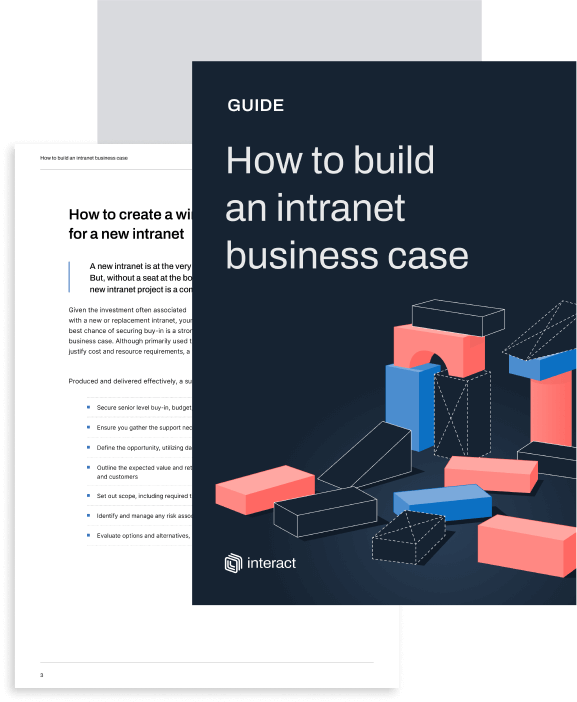If you’re one of the many communicators, HRs, IT personnel, or marketers whose organizations would make more sense with an employee experience platform, but who still need to make the business case to senior leadership, then this how-to is for you.
The communicator’s challenge: Buy-in
Getting a business case for a new intranet project signed off is perhaps more challenging than ever. What’s more, despite all of the changes that have taken place in recent times, internal comms teams often still don’t have representation at the highest levels. It all means that comms, HR, and others need to make an even stronger business case to get their intranet project fast-tracked.
Our experience at Interact Software over the last 18 months has been that even if business challenges mean that for some organizations it feels like now is still ‘not the right time’, many companies are making commitments to employee experience-enhancing new intranet projects.
In many of these companies, when senior decision-makers are presented with compelling arguments and facts around possible ROI or time to value, progress can be made.
So, how can you make those winning arguments?
It’s likely that your organization will have its own unique objectives, but we’ve gathered a few robust points below that could help you get your business case across the line.
Strategic benefits and returns of an intranet

Senior decision-makers will be most interested in how an intranet can deliver business-level or strategic returns. Their top-line objective will be to unite all employees behind the organization to achieve common goals and, ultimately, deliver on business outcomes. The first thing you might want to do is make the intranet vs internet comparison to clear up any confusion among your audience.
A successful business case should highlight how an intranet serves as a powerful tool for supporting EX, impacting how employees connect to the identity of the organization, what it does, and its long-term business vision. That sense of purpose and understanding then feeds into how and why employees choose to work for the organization. Engaged and invested employees deliver on important KPIs, increasing efficiency, productivity, and profitability.
Building an intranet business case
Communication management benefits and returns
As an internal communications tool, an intranet is often deployed to address gaps in knowledge or information management. However, with the abundance of interactive, engaging, and employee-focused functionality that now personifies modern-day intranet solutions, they are light years beyond the traditional ‘document dumping ground’. Modern intranet software offers a wealth of benefits that can create a tangible return on investment.
On top of this, the strategic value of effective, clear, and informative communication is now increasingly recognized at board level, especially in the wake of the pandemic. Improving the flow of information within an organization has a ripple effect on measurable outcomes in every area. Putting the right communication tools in place to disseminate information to the right people, through the right channels at the right time, in a format that is easy to consume, and regardless of device or location, is the ultimate business challenge. Senior stakeholders will be interested to understand how an intranet can help to overcome this challenge.
Intranets are essential to Digital Employee Experience (DEX)

Employees are charged with delivering on brand promises, realizing organizational objectives, delivering exceptional experiences for customers, and so much more. In today’s economy, they can be a crucial differentiator when it comes to defining business success. This means the technologies and digital experiences they are exposed to are becoming increasingly important.
Designing digital employee journeys that help people reach their full potential and perform their roles to the best of their abilities is a growing challenge, particularly as today’s workforce is the most diverse in terms of age, experience, and skill set. With the additional challenge posed by managing those experiences at a distance in hybrid working models, there’s a growing demand and strong argument for supporting technology that will ensure all employees – regardless of their location, role, demographic, or needs – can perform their role and connect with their co-workers as easily as possible.
An intranet is more than a communications tool: it is, arguably, the sole employee experience platform purpose-designed to shape the digital workplace. Supporting everything from wellbeing to communicating brand identity and values, it will offer returns on key HR objectives, including workplace satisfaction, retention, engagement, and more.
Building an intranet business case
How to prepare an intranet business case

Once your core arguments are aligned to your business case, it’s important to consider other crucial elements to improve your chances of achieving sign-off from your senior team.
A handful of simple questions will help you approach and shape it correctly, maximizing its chances of success:
- Who is the audience?
- Who are the decision makers?
- How is this business case to be delivered – as a document, presentation, or both?
- Do you have an existing template or framework to work from, or do you need to start from scratch?
- Do you have any specific compliance or regulatory requirements that must be addressed?
- When is the optimum time to submit your business case for consideration?
Establish a plan
There’s no need to put a comprehensive project plan together at this stage – this will usually be defined once your business case gets the green light. Presenting a top-level overview of the project plan is far more advisable.
The high-level plan should present the next steps and outline timescales and key milestones of the project, such as if you need to include a software POC (proof of concept), or whether your timeline can proceed through other procedures.
Your plan should include a review of the business case through to sign off, development, implementation, launch, and beyond. Timescales should be realistic and allow for contingency events and margin for error or delay. Your selected intranet software provider will be able to offer guidelines for realistic timescales. The plan should also highlight any internal resources required to deliver on the project, along with top-level roles and responsibilities.
Building an intranet business case
Presenting your intranet business case
It’s important to make sure your business case is presented professionally, with careful consideration given to design. Headings, graphs, and visuals should be used where appropriate. The business case should include a cover and preview page, followed by a contents page. This will help your reader navigate the different sections, so numbering your pages will be essential.
A formal conclusion with a recommendation statement is a great way to end the business case. The conclusion should reiterate the main points of the business case and align these with the top business objectives you’ve identified. Your final recommendation statement should remind decision-makers that the next step is up to them, reiterate why they should approve investment in your intranet project, and remind them why that action is needed.
If you are presenting your business case in person, keep the presentation to seven slides maximum, each with a clean, simple and consistent design. Presentations are most effective when they use visuals and avoid large chunks of text. You should end on a positive note and ensure you deploy the same approach as your written business case: confident, persuasive language, and knowledge of your chosen options. Make sure you allow time for questions, and always leave a paper-based takeaway document, preferably a one-pager that is easy to digest and conveys your key points.
Next steps for creating your intranet business case
A convincing intranet business case could propel your organization forwards against a backdrop of growing challenges. While this fairly high-level overview should help to create a business case that captivates and persuades senior stakeholders, we recommend taking a deeper dive into what it takes to get that business case across the line. In case you missed it, you can now catch up with part one of our on-demand intranet best practices webinar series, Why you probably have a strong business case for a new intranet. We hope it gives you some extra insight into making your project a reality.


